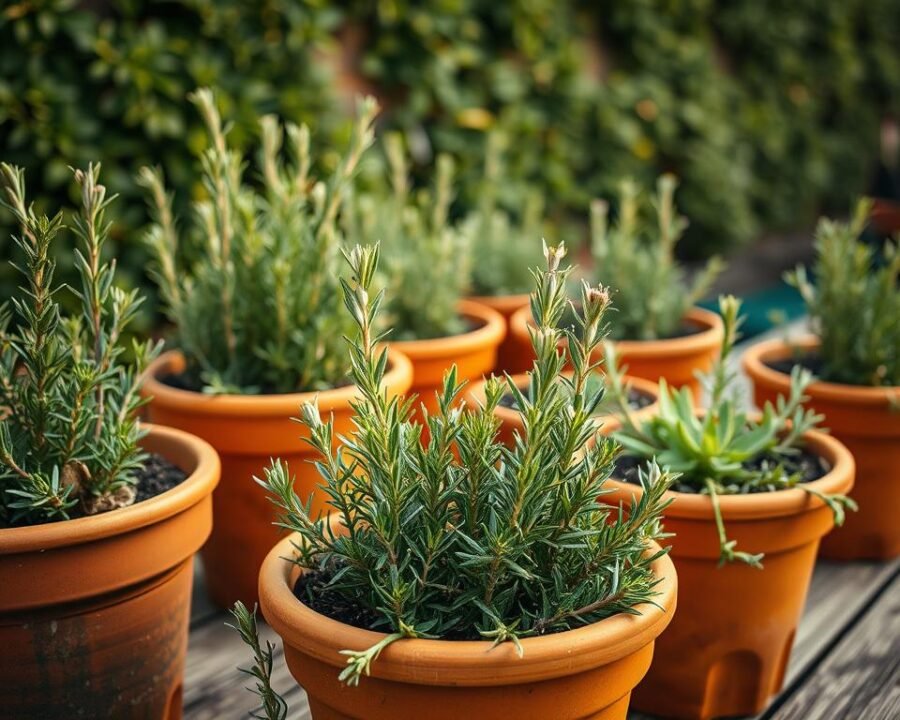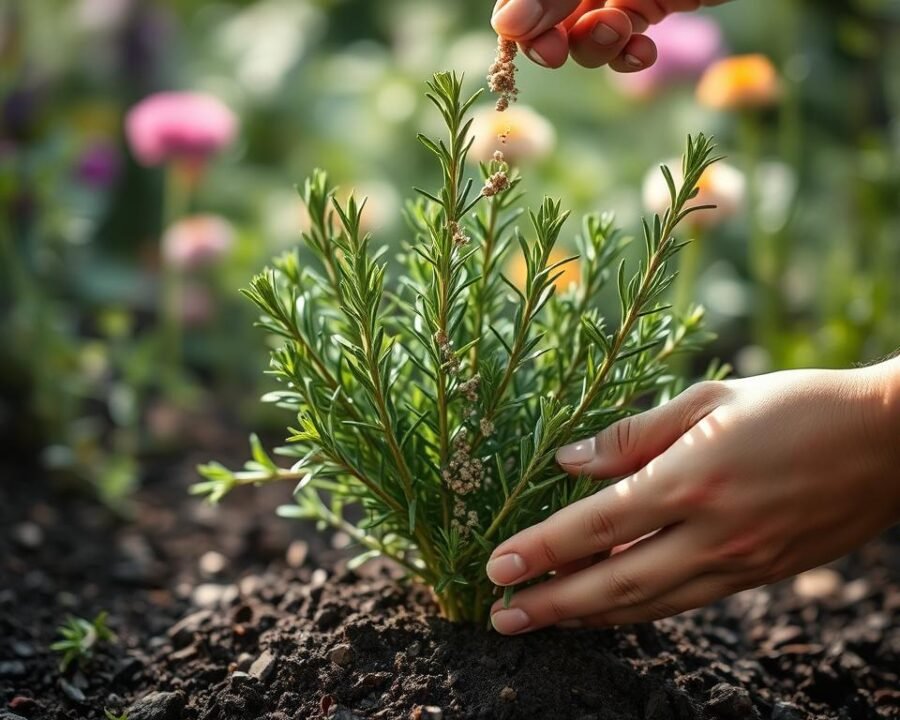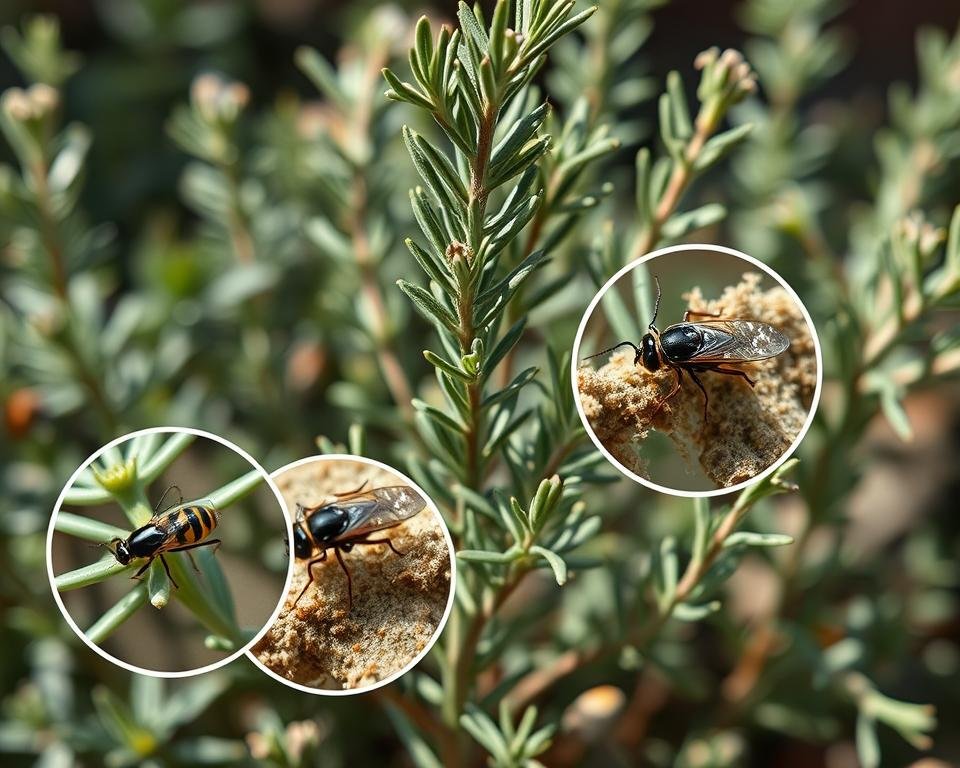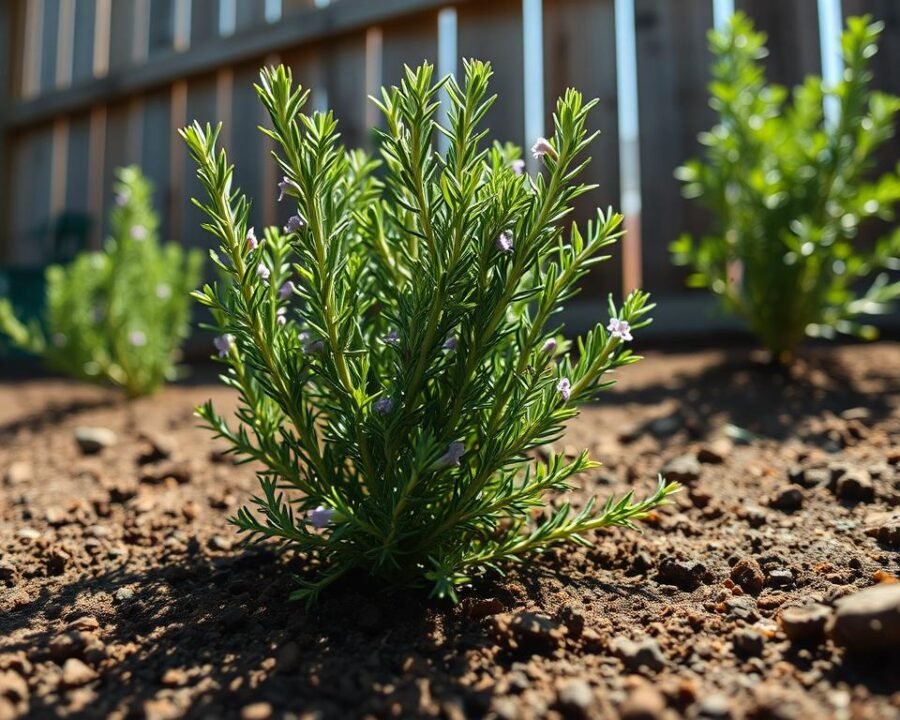There’s something magical about stepping into a garden filled with fragrant, resilient rosemary. Its pine-like scent and hardy nature make it a favorite among gardeners and chefs alike. Whether you’re a beginner or a seasoned green thumb, nurturing this versatile herb can be simpler than you think.
With proper sunlight and well-draining soil, rosemary thrives effortlessly. It loves warm climates but adapts well to containers, making it accessible no matter where you live. Our proven methods ensure success, even if you’re just starting.
Expert horticulturist Weslie Etienne Pierre agrees: “This resilient herb rewards patience with endless flavor and beauty.” From seasoning dishes to enhancing garden aesthetics, its uses are boundless. Let’s explore the essentials—sunlight, soil, and smart watering—to help your plants flourish.
Key Takeaways
- Rosemary thrives with minimal care, perfect for busy gardeners.
- Requires at least 6 hours of direct sunlight daily.
- Ideal for USDA zones 7-11, with container solutions for cooler areas.
- Drought-tolerant once established, reducing watering needs.
- Adds culinary and aromatic value to any garden.
Why Rosemary Is the Herb Everyone’s Growing
Few herbs blend beauty, fragrance, and practicality like rosemary plant. Its silvery-green leaves and woody stems thrive in full sun, requiring little water once established. Whether outdoors or in pots, it’s a low-maintenance superstar.
Benefits of Growing Rosemary
This Mediterranean native is drought-tolerant, needing water just twice weekly. Its natural pest resistance means fewer chemicals in your garden. Indoors, it purifies air while adding a fresh scent.
Studies suggest rosemary’s memory-enhancing properties date back to ancient Greece. Today, its essential oils are prized for focus and relaxation. Even bees love its late-spring blooms!
Popular Uses in Cooking and Beyond
In the kitchen, fresh dried leaves elevate lamb, bread, and infused oils. Aromatic bundles make fragrant sachets or wreaths. For a spa-like touch, add sprigs to bathwater or DIY cleaning sprays.
From grill rubs to herbal teas, rosemary’s uses are as endless as its charm. No wonder it’s a favorite among chefs and crafters alike.
How to Grow Rosemary Herb Plant Everyone Is Using
Climate compatibility is key when picking a rosemary cultivar. Whether you prefer upright shrubs or trailing ground covers, selecting the right type ensures success. Your local weather and space constraints guide this choice.
Choosing the Right Variety for Your Climate
Cold-hardy types like ‘Arp’ survive winters in USDA zones 6-10, while tender varieties like ‘Tuscan Blue’ excel in warmer zones. For ground cover, ‘Prostratus’ spreads beautifully in rock gardens.
| Variety | Growth Habit | Best Zones |
|---|---|---|
| Tuscan Blue | Upright (4-6 ft) | 7-11 |
| Prostratus | Trailing | 8-11 |
| Arp | Bushy | 6-10 |
Starting from Seeds vs. Buying Plants
Seeds offer affordability but demand patience—germination takes 14-30 days with a 25% success rate. Use heat mats and sterile soil mix for better results. For instant impact, Bonnie Plants® starters or Alder & Oak’s 12″ shrubs save 3 months of growth time.
Time planting after the last frost in spring for outdoor success. Container gardening extends options for cooler seasons. Either way, well-drained soil and full sun remain non-negotiable.
Ideal Conditions for Planting Rosemary
The secret to lush rosemary lies in mimicking its native habitat. Mediterranean climates offer sandy soil, abundant sunlight, and mild winters. Replicating these conditions ensures vigorous growth and aromatic leaves.
Best Time to Plant
Timing depends on your USDA zone. Spring is safest after the last frost—wait an extra week for cooler regions. Fall planting works in zones 8–11, where winters stay above 30°F.
| USDA Zone | Spring Planting | Fall Planting |
|---|---|---|
| 6–7 | Mid-April | Not recommended |
| 8–9 | March | October |
| 10–11 | Year-round | Year-round |
Sunlight Requirements
Rosemary craves 6+ hours of direct sunlight daily. Less light reduces essential oil production, weakening flavor and fragrance. In hot climates (zones 10–11), afternoon shade prevents heat stress.
Soil Preferences
Well-drained, sandy soil with a pH of 6.0–7.0 is ideal. Amend heavy clay with 30% coarse sand and 3″ of compost. For containers, Miracle-Gro® Performance Organics mix provides perfect drainage.
Avoid waterlogged roots—rosemary despises “wet feet.” Test drainage by digging a 12″ hole: if water pools after rain, raise beds or opt for pots.
Step-by-Step Guide to Planting Rosemary
Proper planting sets the foundation for healthy, aromatic rosemary. Whether in pots or the ground, these steps ensure strong roots and lush growth.

Preparing the Soil or Container
Terra cotta pots are ideal—their porous walls prevent root rot. Add a drainage layer of gravel before filling with a sandy mix. For in-ground planting, mound soil 6 inches high to improve water runoff.
Match the rootball’s depth to its nursery container. Keep it 1 inch above the soil line to avoid stem rot. Companion planting with lavender or thyme enhances pest resistance.
Spacing and Depth for Optimal Growth
Allow 2–3 feet of space between plants for hedge formation. In containers, limit to one per pot to avoid crowding. Mulch lightly, keeping it 2 inches from stems to deter mold.
This gardening staple thrives when given room to breathe. Follow these tips, and your rosemary will reward you with years of fragrance and flavor.
Watering Your Rosemary Plant the Right Way
Balanced moisture is the key to thriving rosemary. This Mediterranean native prefers neglect over pampering—its woody stems store water efficiently. Overwatering invites root rot, while too little stunts growth.
Frequency Matters
Wait until the top 2 inches feel soil dry—typically every 7–10 days. In winter, cut frequency by half. Group it with oregano or sage; they share similar needs.
Yellow lower leaves signal excess water. Self-watering pots often drown roots; terra cotta breathes better. Use a rain gauge to track natural hydration.
Master the Finger Test
Push a finger into the soil dry zone. If it’s cool or damp, wait a few more days. In humid climates, extend intervals. For pots, lift them—lightweight means thirsty.
Adjust by season: summer heat demands vigilance, while autumn rains may skip manual watering entirely. This way, your rosemary stays lush without fuss.
Feeding and Fertilizing Rosemary
Nourishing rosemary properly unlocks its full potential in your herb garden. Unlike heavy feeders, this evergreen thrives on minimal but strategic nutrition. Overdoing it harms more than helps—balance is key.

Compost: Nature’s Slow-Release Fuel
Work 2 inches of compost into the soil each spring and fall. This enriches drainage and microbial activity. For potted plants, mix 1 part compost with 3 parts sandy soil.
Try compost tea every 6 weeks: steep aged compost in water for 48 hours, then drench the soil. It’s a gentle growth booster without synthetic salts.
Organic Fertilizers for Vigorous Plants
Earthworm castings every 90 days provide steady nutrients. For container rosemary, apply fish emulsion (5-1-1 ratio) monthly. Avoid high-phosphorus blends—they stunt leaf flavor.
Foliar sprays with diluted seaweed extract strengthen stems. Always test soil pH first; rosemary prefers slightly acidic to neutral conditions (6.0–7.0).
- Seasonal care: Focus on early spring and late fall feedings.
- Organic wins: Synthetics risk salt buildup in drought-tolerant plants.
- Less is more—yellow tips signal overfeeding.
Pruning and Maintaining Your Rosemary
Keeping rosemary vibrant requires smart pruning techniques. Strategic cuts prevent leggy growth and boost flavor intensity. Follow these tips to ensure your plant thrives year-round.
Revitalizing Foliage
Remove dead or yellowed leaves promptly to redirect energy. Sterilize shears with rubbing alcohol to avoid spreading disease. Aim for a *45-degree angle* just above leaf nodes—this encourages faster healing.
Thin dense areas to improve air circulation. Focus on inner branches where moisture lingers. This simple step reduces mold risks without sacrificing aesthetics.
Shaping for Density
Pinch back new growth by 1–2 inches monthly for bushier results. Hard pruning (up to ⅓ of the plant) works best in early spring. Avoid late-season cuts—they weaken winter resilience.
For topiary designs, trim lightly but often. Use soft ties to train stems into spirals or cones. Filtered light during dormancy keeps shapes intact.
“Rosemary’s woody structure demands respect—prune with purpose, not haste.”
Deadheading spent flowers prolongs vegetative growth. However, leaving some blooms attracts pollinators. Balance depends on whether you prioritize harvests or biodiversity.
Troubleshooting Common Rosemary Problems
Even resilient rosemary faces challenges—spotting issues early keeps plants thriving. Most troubles stem from pests or moisture imbalances. With simple fixes, your greens rebound stronger.

Unwanted Visitors: Spider Mites and Whiteflies
Tiny webs or sticky leaves signal spider mites or whiteflies. These pests drain sap, weakening flowers and foliage. Act fast to stop infestations.
| Pest | Signs | Solution |
|---|---|---|
| Spider Mites | Fine webs, yellow speckles | Neem oil spray every 21 days |
| Whiteflies | Sticky residue, flying specks | DIY soap spray (1 tsp dish soap + 1 qt water) |
For severe cases, prune affected stems. Boost air circulation to deter future attacks. Ladybugs are natural predators—welcome them!
Fungal Foes: Powdery Mildew and Root Rot
White powder on leaves? That’s powdery mildew. Overwatering causes root rot—both thrive in dampness. *Preventative measures* save harvests.
- Drainage: Mix sand into soil or use raised beds.
- Humidity: Space plants for airflow; avoid wetting leaves.
- Natural treatments: Dust cinnamon on soil to block fungi.
In winter, reduce watering. Zone 7 gardeners should mulch roots for frost protection. Discard badly infected plants to protect neighbors.
“Rosemary’s toughness shines when given smart care—dry roots and sunlight are its armor.”
Watch for early signs like wilting or discolored flowers. Adjust care with the seasons, and your rosemary will flourish year-round.
Growing Rosemary Indoors vs. Outdoors
Rosemary adapts beautifully to both indoor and outdoor settings, offering flexibility for gardeners in any climate. While outdoor plants bask in natural elements, rosemary indoors requires slight adjustments to thrive. Both methods reward with aromatic leaves and year-round greenery.
Container Tips for Indoor Success
Choose a pot with drainage holes—terra cotta works best. Place it near a south-facing window for 6+ hours of sunlight. Rotate the plant weekly to ensure even growth.
For low-light spaces, use 6500K grow lights 12 inches above the foliage. Acclimate plants moved outdoors over 7 days to avoid shock. A humidity tray with pebbles prevents dry air damage.
| Factor | Indoor | Outdoor |
|---|---|---|
| Light Source | South window/grow lights | Direct sunlight |
| Watering | Every 10–14 days | Weekly (less in rain) |
| Pest Risk | Spider mites | Whiteflies |
Winter Care in Colder Climates
When temperatures drop below 40°F, heat becomes critical. Insulate windows with thermal curtains or move pots away from drafts. Reduce watering to monthly—dormant plants need minimal moisture.
- Quarantine new plants: Isolate for 2 weeks to prevent pest spread.
- Group plants: Cluster pots to boost humidity naturally.
- Monitor soil: Overly dry indoor air demands occasional misting.
“Indoor rosemary thrives with consistency—steady light and neglectful watering mimic its native hillsides.”
Harvesting and Storing Rosemary
Capturing rosemary’s peak flavor requires perfect time and smart techniques. Whether you’re snipping sprigs for tonight’s roast or preserving a summer bounty, these methods ensure vibrant taste year-round.
Mastering the Harvest
Morning is prime time—essential oils concentrate after dew evaporates. Use clean shears to cut 4–6 inch stems, choosing woody bases with fresh growth. Avoid overharvesting; never take more than ⅓ of the plant per season.
For fresh dried leaves, strip them post-harvest or hang whole stems. Summer yields the most aromatic sprigs, but spring and fall work too. Always leave some growth to sustain the plant.
Preservation Techniques
Dehydrators excel for efficiency: 95°F for 8 hours retains color and potency. Air-drying takes 7–10 days—bundle stems with twine in a dark, ventilated spot. Test brittleness before storing.
- Freezing: Pack chopped leaves in olive oil ice cubes for sauces.
- Vacuum sealing: Extends shelf life to 18 months vs. 6 months for jar-stored dried leaves.
- Creative options: Infuse salts or sugars for gourmet pantry staples.
“Rosemary’s oils are fleeting—harvest at dawn, store with care, and savor the Mediterranean sun in every bite.”
Label containers with dates; fresh dried rosemary loses potency after a year. This guide ensures your harvests stay flavorful through every season.
Conclusion
With proper care, rosemary becomes a garden superstar, offering flavor and fragrance for years. Stick to the basics—ample sunlight, well-drained soil, and occasional pruning—for robust plants.
Share your progress photos! Pair rosemary with lavender or sage for a pest-resistant trio. Need reminders? Grab our free care calendar to stay on track.
As horticulturist Weslie Etienne Pierre notes: “A single rosemary bush can yield a pound of aromatic leaves—proof that small efforts bring abundant rewards.” Ready to grow rosemary like a pro? Start today!
